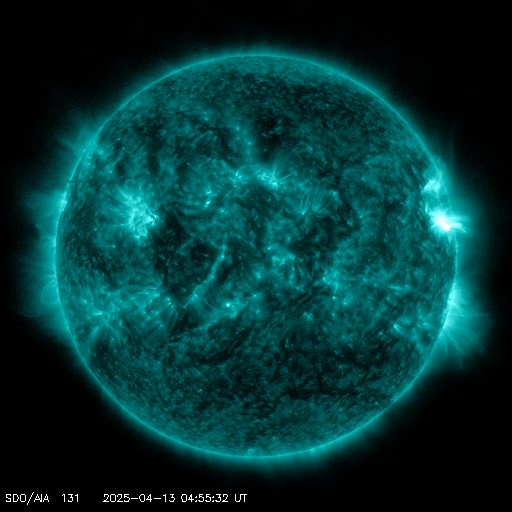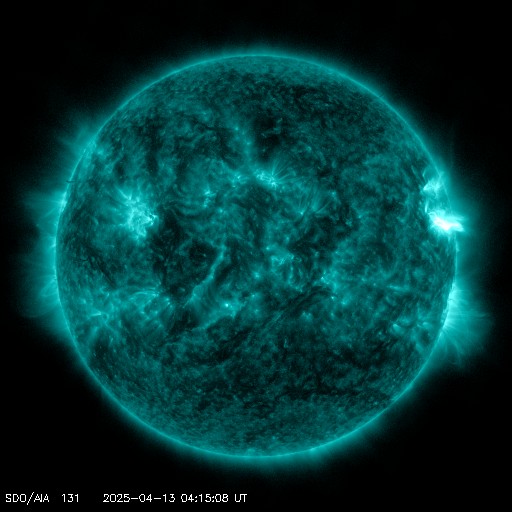Het archief bekijken van dinsdag 30 april 2024
Dagelijks bulletin over zonne- en geomagnetische activiteit van het SIDC
Datum verslag: 2024 Apr 30 1231 UTC
SIDC Prognose
Zonnevlammen
M-class flares expected (probability >=50%)
Geomagnetisme
Quiet (A<20 and K<4)
Proton Flux monitor
Quiet
| 10cm flux | Ap | |
|---|---|---|
| 30 Apr 2024 | 132 | 007 |
| 01 May 2024 | 128 | 014 |
| 02 May 2024 | 124 | 016 |
Zonnevlekkengebieden en zonnevlammen
Solar flaring activity over the past 24 hours was at moderate levels. The largest flare was a M1.6-flare, with peak time 01:14 UTC on April 30 associated with NOAA AR 3654 (beta-gamma- delta). There are currently 6 numbered active regions on the visible disk. NOAA AR 3654 (beta-gamma-delta) is the largest, most magnetically complex region and has produced most of the flaring activity in the last 24 hours. NOAA AR 3652 (alfa) has started to rotate over the west limb. All other regions were inactive and stable. The solar flaring activity is likely to be at moderate levels over the coming days with C-class flares expected, M-class flares possible and a chance for an X-class flare.
Coronale massa uitstoten
A Coronal Mass Ejection (CME), was detected at 12:36 UTC on April 29, in LASCO C2 data. The CME is associated with an eruption seen in SDO/AIA 171 and 193 at 07:53 UTC on April 29 associated with NOAA AR 3654. Further analysis is ongoing.
Coronale gaten
A long negative polarity coronal hole stretching from high northern latitudes down to the equator continues to pass the central meridian. The high-speed stream emanating from it might arrive to Earth late on May 1st.
Zonnewind
Over the past 24 hours the solar wind conditions were enhanced until around 17:45 UTC on April 29 when they started to decline to slow solar wind conditions. The solar wind velocity varied in the range of 374 to 505 km/s. The interplanetary magnetic field varied between 1 nT and 5 nT, with the Bz reaching a minimum value of -3 nT. The phi-angle was mainly in the positive sector (directed away from the Sun) with periods in the negative sector. The solar wind conditions are expected become elevated with a possible mild high-speed stream arrival on and May 1st.
Geomagnetisme
Geomagnetic conditions were globally quiet (K 1-2) and locally reached unsettled conditions (K Bel 3). Quiet to unsettled conditions are expected in the next 24 hours.
Proton flux niveaus
Over the past 24 hours the greater than 10 MeV GOES proton flux was at background levels and is expected to remain so over the next days.
Elektronenfluxen in geostationaire baan
The greater than 2 MeV GOES 16 electron flux was below the 1000 pfu threshold and is expected to remain so in the upcoming days. The 24h electron fluence was at nominal level and is expected to remain so in the next days.
Het geschatte internationale zonnevlekkengetal (ISN) van vandaag: 088, gebaseerd op 16 stations.Zon indexen voor 29 Apr 2024
| Wolfgetal Catania | 138 |
| 10cm zonneflux | 138 |
| AK Chambon La Forêt | 013 |
| AK Wingst | 009 |
| Geschatte Ap | 008 |
| Geschat internationaal zonnevlekkengetal | 104 - Gebaseerd op 31 stations |
Overzicht opvallende gebeurtenissen
| Dag | Start | Max | Einde | Locatie | Sterkte | OP | 10cm | Catania/NOAA | Soorten radio-uitbarstingen |
|---|---|---|---|---|---|---|---|---|---|
| 30 | 0046 | 0114 | 0131 | S06W50 | M1.6 | SF | 74/3654 | VI/1 |
Aangeboden door het Solar Influences Data Analysis Center© - SIDC - Verwerkt door SpaceWeatherLive
Alle tijden in UTC
<< Keer terug naar de dagelijkse overview pagina
Op basis van de huidige parameters is er in de nabije toekomst een beperkte kans op poollicht op de volgende locaties van de hoge breedtegraad
Gillam, MB, Yellowknife, NTLaatste nieuws
Laatste forumberichten
Steun Poollicht.be!
Om ook bereikbaar te blijven bij grote poollichtkansen hebben we een zware server nodig die alle bezoekers aankan. Doneer en steun dit project zodat we online blijven en je geen enkele poollichtkans mist!

Laatste alerts
05:12 UTC - Zonnevlam
Matige M2.31 zonnevlam
04:54 UTC - Radio blackout
Kleine R1 radio blackout gedetecteerd (≥M1 - momenteel: M1.89)
04:48 UTC - Zonnevlam
Matige M1.12 zonnevlam
04:24 UTC - Zonnevlam
Matige M1.13 zonnevlam
04:09 UTC - Radio blackout
Kleine R1 radio blackout gedetecteerd (≥M1 - momenteel: M1.13)
Ruimteweer feitjes
| Laatste X-klasse uitbarsting | 28/03/2025 | X1.1 |
| Laatste M-klasse uitbarsting | 13/04/2025 | M2.2 |
| Laatste geomagnetische storm | 06/04/2025 | Kp5 (G1) |
| Zonnevlekkenloze dagen | |
|---|---|
| Laatste zonnevlekkenloze dag | 08/06/2022 |
| Maandelijks gemiddeld zonnevlekkengetal | |
|---|---|
| maart 2025 | 134.2 -20.4 |
| april 2025 | 136.4 +2.2 |
| Afgelopen 30 dagen | 134.7 -7.2 |





